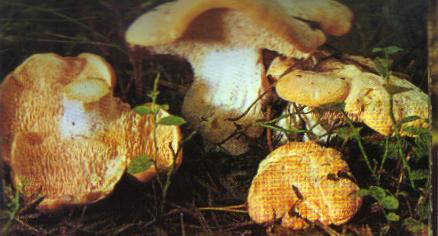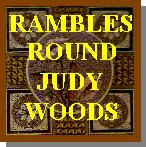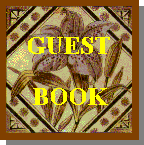





What makes Judy Woods worth visiting is the trees. Judy Woods is a mature, deciduous woodland - deciduous with a capital 'D'. A few conifers are in evidence (about three!) but these are swallowed by vast and venerable saturation of oak, beech, silver birch, horse chestnut, ash and of course the ever present sixteenth century introduction, sycamore, which is becoming something of a pest. Some of these trees are very old, lofty and awe inspiring, many of them dating from the eighteenth century or earlier. There is certainly no comparable woodland in the Bradford Metropolitan area - Judy Woods has a character all of its own. The first impression is of vastness. This is accentuated in summer when the leaf canopy is on, and the woodland is bathed in an ever changing display of lights and shadows. It seems like a vast jungle, despite the fact that a forty-five minute walk can take you from one end to the other. Different parts of the woods have different characteristics. The central part of Royds Hall Great Wood, for example, contains venerable oaks with such a dense leaf canopy that they shut out most of the light, leaving a wilderness of dead leaves in continual twilight. Jagger Park Wood on the other hand, consists largely of young birches, and these, coupled with areas of dense undergrowth and few paths, create, (in summer) a jungle where a visitor unfamiliar with the area might easily get lost. The contrasts are endless, and beyond the scope of this website. When I worked there, I visited the woods on an average of five days a week for about six months and the impression was never the same twice. The vagaries of light, season, location and climate turn the woods into a kaleidoscope of light, shade and colour that never ceases to amaze, and which draws the visitor again and again. Here is a rough seasonal calendar of the cycle of life in Judy Woods... In January and early February there is little to observe. The woods are held fast in the grip of winter. An occasional fox is in evidence, and the trees stand stark and bare against the snow. March/April sees the beck running high, and damming caused by the flood waters, which bring down woodland debris and rubbish from urban areas upstream. One of the first plants in evidence is the lesser celandine (ranunculus ficaria) which appears on stream banks about this time. Sometimes known as pilewort the lesser celandine is unmistakeable with arrowhead-like leaves and small, yellow, buttercup-like flowers (it belongs to the buttercup family - ranunculaceae). Like the buttercup, ranunculus ficaria is poisonous, and, appropriately enough, sap from the arrow-shaped leaves was once used to poison the tips of real arrowheads! Alongside the lesser celandine we see its close relative, the wood anemone or windflower (Anemone Nemorosa), with its delicate white flower (again buttercup-like). Like most members of this genus (ranunculaceae) anemone nemorosa contains the poisonous alkaloid proto-anemonin which is caustic, and can cause blisters, and intestinal inflammation if eaten. By the time the trees come into leaf, both these species (so numerous in their prime) are gone. April/May sees the trees coming into leaf and the woods change rapidly. This is a lovely time of the year. Now the bluebells arrive in great profusion. There is an interesting story connected with the humble bluebell. Linnaeus classified it as hyacinthus non scriptus because there was no writing on the petals of the flower. On true hyacinths the spots on the petals make out the greek letters AI, meaning 'alas!' This was said to be the dying cry of the youth Hyacinthus, killed while sporting with Apollo who out of pity turned him into a flower. Some of the bluebells in Judy Woods are white, particularly in isolated areas. Along with the bluebell late spring brings other species; first comes the red campion (silene dioica) which is very common, the ramsons, or wild garlic, with its highly distinctive smell and pretty white flower also makes its appearance. Insect life begins to stir and ants and bees become numerous (not to mention midges!). The most interesting species I have observed down the woods at this time of the year is the lungwort (pulmonaria officinalis), which are rare growing in the wild, and are usually a garden escape, though in this case a long way from a garden. I have not heard cuckoos in Judy Woods but swallows put in an appearance about this time doing their fantastic aerobatics over the ravine by the 'Snoddy'. Now it is early summer and we see the complete unfurling of what Judy Woods has to offer - the herb roberts and pink purslanes growing by the stream, the wood forget-me-nots, the speedwells. And of course we encounter the alien intruders that choke everything else - the himalayan balsam (policemen's helmets) with its purple flowers, the butterbur, with its sour smelling, rhubarb-like leaves, and of course the ubiquitous rosebay willow herb, (epilobium augustifolium) which grows in large colonies, drawing attention from its smaller english relative the great willow herb, which can be seen in odd, isolated spots. Foxgloves occur but do not abound. Certain areas are clothed in deep bracken, the sharp stems of which can neatly slice the careless hand. Midsummer to autumn sees the blooming of the fungi. The distribution of species seems to vary from area to area in the woods. The type of mushroom known as russula is abundant everywhere, some with yellow caps, others with reddish caps, all easily distinguishable by their pure white flesh which crumbles very easily. Some of these are edible, others are not. The only sure way is to taste them; the inedible russula known as the sickener will make its identity known to you in no uncertain manner if you happen to taste one! The ones that don't taste peppery are edible, but they have no flavour and are not really worth sampling. More promising for the would-be-gourmet are the genus of tubed fungi known as boletaceae. It is a safe rule-of-thumb to say that all members of this family are edible. (The sole exception is the boletus satanus or devil's bolete which is easily distinguishable by its colouring, and is virtually unknown in the north of England.) The boletes are easy to spot by virtue of their sponge-like tubes. Avoid old specimens, as these are usually infested with the maggots of the fungus gnat, and ignore those that taste bitter - they will probably give you indigestion. Tastiest of all are the ceps and penny bun boletes, which are far nicer than the common edible mushroom, and are sold in supermarkets on the continent, being a prime ingredient in french cuisine. More common is the rough-stemmed birch boletus, which enjoys a symbiotic relationship with birch trees. It is quite unmistakeable with its reddish-brown cap, its rough, speckled stem and flesh which turns black/blue when broken. Fear not! Though not as good as those previously mentioned it is quite palatable, and is found,(naturally enough) in Jagger Park Birch Wood, along with boletus badius, the bay bolete, which is less frequent. Dried boletes can be purchased at delicatessen stores in this country, and in Judy Woods during the season you can see Bradford residents of eastern european extraction picking these 'nasty looking toadstools' by the sackful! Not all woodland fungi are safe to eat. Both poisonous death caps and deadly white destroying angels have been observed in Judy Woods. The poisonous panther cap (amanita pantherina) is common. Beware of anything that smells of raw potatoes. Of the amanita genus only the grisette (amanita vaginata) is safely edible along with the blusher (amanita rubescens) which looks too much like amanita pantherina for comfort. The answer is simple. If in doubt dont, that is the safest formula. Also common in Judy Woods is the common earth ball (schleroderma). This is found on peaty soils and looks just like a potato. If cut it exudes a bitter smell, and inside may be seen white flesh with black spore-bearing areas. In old specimens you are powdered with black dust! Schleroderma (means 'scaly skin') is lime hating and likes deep acid soil. Consequently, although common in this area it is quite rare in the limestone areas of the northern dales. The earth ball is interesting but poisonous, and should not be eaten. Curiously enough, the fly agaric, the original red/white spotted fairy mushroom, is uncommon in Judy Woods, although there is occasionally an eruption of them, as in the autumn of 1981, when they filled the wood! Other less common fungi found in the woods include the stinkhorn (phallus impudicus) puffballs (lycoperdon perlatum) and most unusual of all the wood urchin (hydnum repandum) which instead of the usual gills or tubes sports clusters of rubbery spines! To cover all the different species found in Judy Woods is beyond the scope of this website, and the visitor is advised to consult his/her own reference sources. Every year brings something new to Judy Woods, and the determined explorer will be sure to find something of interest. The mushroom season takes us through autumn into winter. Autumn is a time of dead and dying leaves, woodsmoke and squirrels preparing for the winter. All of these unfortunately are of the grey variety (squirius carolinensis). The native red squirrel is unknown here, probably because of the almost total abscence of the conifers where they are usually found. The grey squirrels are abundant, though it cannot be said how long this situation will remain, as they are constantly being shot at by youths with air rifles. The onset of winter brings us fullcircle and we wait and see what another year will offer. There is always something new. Pollution is a problem for Judy Woods, and so is vandalism, but the venerable trees and shady paths remain- a playground for present and hopefully for future generations.





